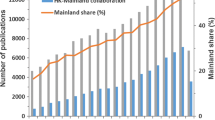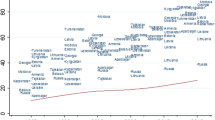Abstract
Collaboration is one of the remarkable characteristics of contemporary basic research. Using bibliometric method, we quantitatively analyze international collaboration publication output between China and the G7 countries based on Science Citation Index. The results indicate that international collaboration publication output between China and the G7 countries has shown exponential growth aroused by the growth of science in China. USA is the most important collaboration country and the international collaboration between China and the G7 countries display differences at each research field.
Similar content being viewed by others
References
Arunachalam, S., Srinivasan, R., Raman, V. (1994), International collaboration in science: Participation by the Asian giants. Scientometrics, 30(1):7–22
Arunachalam, S., Doss, M. J. (2000), Mapping international collaboration in science in Asia through coauthorship analysis. Current Science, 79(5): 621–628.
Beaver, D. D., Rosen, R. (1978), Studies in scientific collaboration part I. the professional origins of scientific co-authorship. Scientometrics, 1(1): 65–84
Beaver, D. D., Rosen, R. (1979), Studies in scientific collaboration part II. scientific co-authorship, research productivity and visibility in the France scientific elite. Scientometrics, 1(2): 133–149.
Beaver, D. D. (2001), Reflections on scientific collaboration (and its study): past, present, and future. Scientometris, 52(3): 365–377.
Braun, T., Gómez, I., Méndez, A., Schubert, A. (1992), International co-authorship patterns in physics and its subfields, 1981–1985. Scientometrics, 24(2): 181–200.
Frame, J. D., Carpenter, M. P. (1979), International research collaboration. Social Studies of Science, 9(4): 481–497.
Frame, J. D., Narin, F. (1987), The growth of Chinese scientific research, 1973–84. Scientometrics, 12(1–2): 135–144.
Garg, K. C., Kumar, S., Lal, K. (2006), Scientometric profile of Indian agricultural research as seen through Science Citation Index Expanded. Scientometrics, 68(1): 151–166.
Garg, K. C., Padhi, P. (2001), A study of collaboration in laser science and technology. Scientometrics, 51(2): 415–427.
Glänzel, W., de Lange, C. (2002), A distributional approach to multinationality measures of international scientific collaboration. Scientometrics, 54(1): 75–89.
Glänzel, W., Winterhader, M. (1992), International collaboration of three east european countries with Germany in the sciences, 1980–1989. Scientometrics, 25(2): 219–227.
Glänzel, W. (2001), National characteristics in international scientific co-authorship relations. Scientometrics, 51(1): 69–115.
Glänzel, W., Schubert, A. (2003), A new classification scheme of science fields and subfields designed for scientometric evaluation purposes. Scientometrics, 56(3): 357–367.
Guo, H. (2006), Analysis of rankings and citation impact of Chinese science and technology papers in the world. Science and Technology Review, 24(6): 81–85.
Guo, J. J., Cui, L., Zhang, H., Han, D. Y., Chen, J. (2000), Bibliometrics study of international cooperation in science and technology. Journal of the China Society for Scientific and Information Science, 19(6): 659–662.
ISTIC (Institute of scientific and technical information of China), Annual Research Report of Chinese S&T Papers Statistics and Analysis 2004. Beijing, Scientific and Technical Documents Publishing House, 2006.
Jin, B. H., Rousseau, R. (2007), China’s Quantitative Expansion Phase Exponential Growth but Low Impact. Retrieved March 12, 2007, http://hdl.handle.net/1942/876
Katz, J. S., Martin, B. R. (1997), What is research collaboration? Research Policy, 26(1): 1–18.
Katz, J. S. (2000), Scale-independent indicators and research evaluation, Science and Public Policy, 27: 23–36.
King, D. A. (2004), The scientific impact of nations. Nature, 430: 311–316.
Kumar, S., Garg, K. C. (2005), Scientometrics of computer science research in India and China. Scientometrics, 64(2): 121–132.
Liu, Y., Chang, Q. (2001), Scientometrical measurement and evaluation on international collaboration of basic research in China. Journal of Management Sciences in China, 4(1): 64–74.
Luukkonen, T., Persson, O., Sivertsen, G. (1992), Understanding patterns of international scientific collaboration. Science,Technology & Human Values, 17(1): 101–126
Luukkonen, T., Tijssen, R. J. W., Persson, O., Sivertsen, G. (1993), The measurement of international scientific collaboration. Scientometrics, 28(1): 15–36
May, R. M. (1997), The scientific wealth of nations. Science, 275: 793–796.
NSB (National Science Board), Science & Engineering Indicators. Arlington, VA, USA, 2006.
Okubo, Y., Miquel, J. F., Frigoleito, L., Dore, J. C. (1992), Structure of international collaboration in science: typology of countries through multivariate techniques using a link indicator. Scientometrics, 25(2): 321–351.
Price, D. De S., Little Science, Big Science. New York: Columbia University Press. 1963.
Schubert, A., Braun, T. (1986), Relative indicators and relational charts for comparative assessment of publication output and citation impact. Scientometrics, 9(5–6): 281–291.
Schubert, A., Braun, T. (1990), International collaboration in the sciences, 1981–1985. Scientometrics, 19(1–2): 3–10.
Wang, Y., Wu, Y. S., Pan, Y. T., Ma, Z., Rousseau, R. (2005), Scientific collaboration in China as reflected in co-authorship. Scientometrics, 62(2): 183–198.
Zhang, H. Q., Guo, H. (1997), Scientific research collaboration in China. Scientometrics, 38(2): 309–319.
Zhou, P., Leydesdorff, L. (2006), The emergence of China as a leading nation in science. Research Policy, 35(1): 83–104.
Zitt, M., Bassecoulard, E., Okubo, Y. (2000), Shadows of the past in international cooperation: collaboration profiles of the top five producers of science. Scientometrics, 47(3):627–657.
Author information
Authors and Affiliations
Corresponding author
Rights and permissions
About this article
Cite this article
He, T. International scientific collaboration of China with the G7 countries. Scientometrics 80, 571–582 (2009). https://doi.org/10.1007/s11192-007-2043-y
Received:
Published:
Issue Date:
DOI: https://doi.org/10.1007/s11192-007-2043-y




